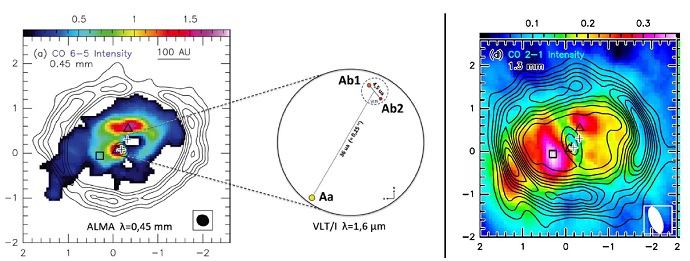30 OCTOBER 2014
An international team of astronomers, including researchers at the LAB (CNRS/Université de Bordeaux), IPAG (CNRS/Université Joseph Fourier Grenoble 1) and IRAM (CNRS/MPG/IGN), has carried out the most accurate study so far of the cocoon of gas and dust surrounding the GG Tau A system. By combining complementary observations at submillimeter (ALMA and IRAM) wavelengths with those at infrared (VLTI/ESO) wavelengths, the researchers were able to identify the complex dynamics at work in GG Tau. For the first time, they detected motion of matter showing that exoplanets can form not only around one of the members of this trio of young stars, but also much further out in the disc surrounding the three stars. These observational findings, published in the October 30 issue of the journal Nature, reveal a more complex story than originally thought.
Although recent observational discoveries have shown the existence of many planets orbiting double stars, their formation ran up against the problem of the gravitational instabilities caused by the binary nature of such stars. Observations of young binary stars are still too scarce to provide a detailed picture of these processes. Until very recently, GG Tau A, located 450 light years from Earth in the constellation Taurus, was thought to be a binary system of two stars, Aa and Ab. However, recent infrared measurements carried out with the VLT and VLTI (ESO) instruments have shown that GG Tau A is in fact a triple star system1: GG Tau Ab is itself a binary star. The central star Aa is far enough away from the Ab pair for it to be surrounded by a circumstellar disc, first observed in 2011 with the IRAM interferometer.
Around this triple star system the researchers have already identified a rotating disc of gas and dust, whose center is cleared by gravitational tidal effects. As the three stars orbit around one another, they create an unstable gravitational region called a cavity, through which matter can only travel before falling onto the central stars. Further away, where the outer ring of matter is located, the gravitational field is no longer disturbed, and the rotating matter can form a stable structure. The existence of a central cavity around GG Tau A, known since the 1990s thanks to observations with the IRAM interferometer, partially confirmed these theoretical predictions. In the 2000s, the presence of gas in the cavity was detected, but the precise dynamics of this gas, which is the key to understanding the accretion mechanisms giving rise to planets, remained largely unknown.
In this new study, complementary observations of carbon monoxide (CO in gaseous form) and of the emission of dust grains around GG Tau A were obtained using the ALMA (Chile) and IRAM (French Alps) interferometers. With unprecedented precision in this field, they unravel some of the mystery surrounding the distribution of matter and the dynamics within the cavity. The images show a stream of gas from the outer ring flowing towards the central stars. The amount of gas transported in this way turns out to be sufficient to feed the inner disc around GG Tau Aa. The observed motion of the gas confirms predictions by earlier numerical simulations. They show that matter from the outer ring is able to feed the inner disc around GG Tau Aa long enough to allow the formation of exoplanets.

Images obtained by ALMA (left) and the IRAM interferometer (right) showing emissions of gas (CO) and dust around the triple star system GG Tau A. Dust emission is shown as black contours, gas emission in color. The central panel shows the position of the three stars observed with the VLTI (ESO).
©Nature/ALMA/ESO/IRAM/CNRS/Université de Bordeaux
Although this result was expected, the next finding was less predictable: the two maps of CO emission reveal remarkable brightness on the outer edge of the ring surrounding the triple star system. Detailed study shows that it is twice as hot as the surrounding environment and that it could point to a young giant exoplanet in formation. This planet could be opening a narrow gap in the outer disc, although detecting such a structure is currently beyond the reach of instruments. IRAM's NOEMA antennas on the Plateau de Bure in the French Alps, scheduled to be operational in the foreseeable future, will no doubt play a valuable role in helping to find out more about GG Tau, a young star system that retains many of its secrets.
Reference
Planet formation in the young, low-mass multiple stellar system GGTau-A, A. Dutrey et al., Nature, 30 October 2014, DOI:10.1038/nature13822













